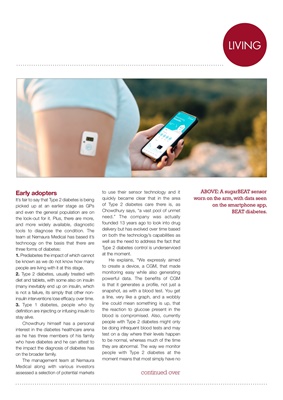
KITLIVING
continued over
Early adopters
It's fair to say that Type 2 diabetes is being
picked up at an earlier stage as GPs
and even the general population are on
the look-out for it. Plus, there are more,
and more widely available, diagnostic
tools to diagnose the condition. The
team at Nemaura Medical has based it's
technoogy on the basis that there are
three forms of diabetes:
1. Prediabetes the impact of which cannot
be known as we do not know how many
people are living with it at this stage,
2. Type 2 diabetes, usually treated with
diet and tablets, with some also on insulin
(many inevitably end up on insulin, which
is not a failure, its simply that other noninsulin interventions
lose efficacy over time.
3. Type 1 diabetes, people who by
definition are injecting or infusing insulin to
stay alive.
Chowdhury himself has a personal
interest in the diabetes healthcare arena
as he has three members of his family
who have diabetes and he can attest to
the impact the diagnosis of diabetes has
on the broader family.
The management team at Nemaura
Medical along with various investors
assessed a selection of potential markets
to use their sensor technology and it
quickly became clear that in the area
of Type 2 diabetes care there is, as
Chowdhury says, "a vast pool of unmet
need." The company was actually
founded 13 years ago to look into drug
delivery but has evolved over time based
on both the technology's capabilities as
well as the need to address the fact that
Type 2 diabetes control is underserviced
at the moment.
He explains, "We expressly aimed
to create a device, a CGM, that made
monitoring easy while also generating
powerful data. The benefits of CGM
is that it generates a profile, not just a
snapshot, as with a blood test. You get
a line, very like a graph, and a wobbly
line could mean something is up, that
the reaction to glucose present in the
blood is compromised. Also, currently
people with Type 2 diabetes might only
be doing infrequent blood tests and may
test on a day where their levels happen
to be normal, whereas much of the time
they are abnormal. The way we monitor
people with Type 2 diabetes at the
moment means that most simply have no
ABOVE: A sugarBEAT sensor
worn on the arm, with data seen
on the smartphone app,
BEAT diabetes.